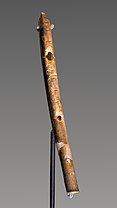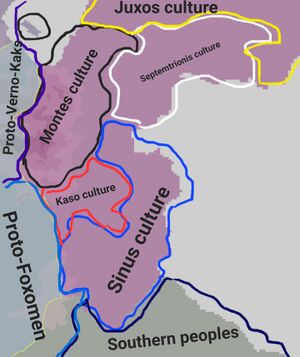Stone Age of Kakland
The Stone Age of Kakland, or the Kakish Stone Age, was a period of time of Kakland beginning with the arrival of the first humans around 1.7 million years to the arrival of modern anatomical humans around 30,000 bce in the Paleolithic and ending with the start of the Bronze Age in 2000 bce.
Lower Paleolithic
The first evidence of human settlement of Kakland occurred west of the Nenan Mountains in central Kakosia with the advent of early stone tools. The first early humans were Homo erectus and Homo heidelbergensis, and later Homo neanderthalensis.
Upper Paleolithic

Modern humans arrived in Kakland around 30,000 with the early Germanic tribes traveling from Thuadia, forming several cultures throughout Kakland. Some major cultures include the Septemtrionis and Montes cultures. Some of these early groups used stone and bone pointed spears and arrowheads, as well as flint blades.
Around 20,000 bce, a new wave of Germanic peoples, the Verno-Kak peoples, went east into central and northern Kakland pushing out the current Germanic groups far south into Morrawia, and farther north into Juxland. By 15,000 bce, many of the original Germanic tribes either were intermixed with the Verno-Kak peoples or were pushed out of Kakland, as well as the Celtic groups which would later become the Eònan. Around 12,000 bce, some Juxland tribes went north to colonize the Stalas and Ismy Islands, and would later disappear by 4,500 bce, either dying off or migrating to better lands due to the lack of resources on the islands.
Mesolithic
By 10,000 bce, the Verno-Kak groups had completely replaced the original Germanic peoples in Kakland, which the culture group would separate into the "Western Kaks (Vernish)" and "Eastern Kaks". During the Mesolithic, a rise of pottery in cultures used to store food and water. An increase of tool usage was also found during this time period.
Neolithic


The Neolithic era began in 4,500 bce in western and central Kakland and Khaygland with the arrival of agriculture. This brought farming of animals and crops, allowed for the domestication of local animals and foods, but also brought new ones to Kakland through early trade. The existence of agriculture allowed for the rise of permanent settlements across Kakland. Many of these tribes rose to create proto-states throughout Kakland, excluding the tribes in the mountainous regions and the peoples of the Gotos Islands. Many cities, including a few modern cities.
Chalcolithic (Copper Age)

M



